A raised garden bed is an elevated structure used to grow plants. Unlike traditional in-ground gardens, raised beds are constructed above the ground level and filled with soil that is higher than the surrounding area. These beds can be made from materials such as wood, concrete blocks, or even recycled items.
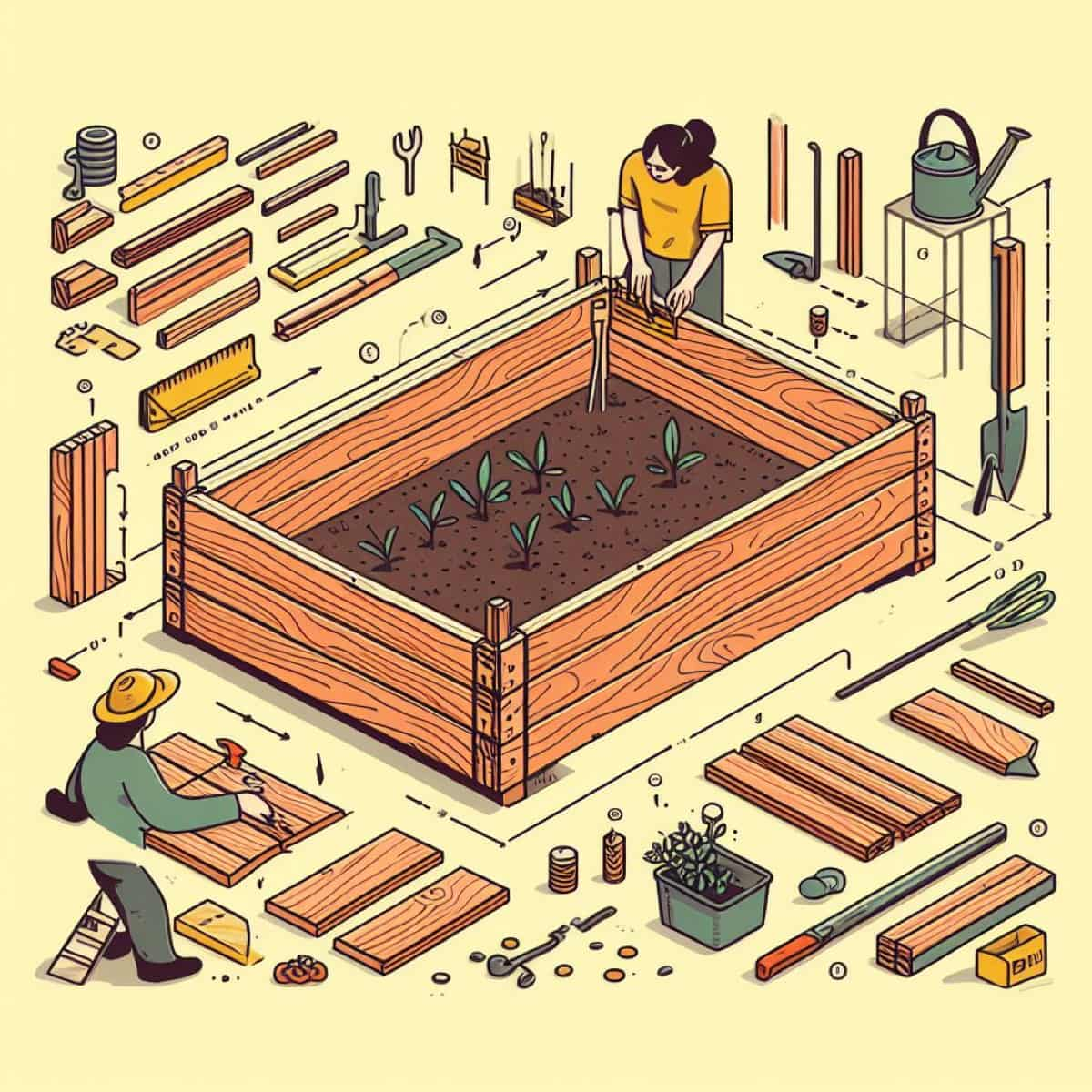
One of the main benefits of a raised garden bed is improved drainage. Additionally, raised beds provide better control over soil quality and allow for easier weed management. Another advantage of raised garden beds is their versatility. They can be customized to fit any space – whether you have a small balcony or a sprawling backyard. This makes them ideal for urban gardening or areas with limited outdoor space.
14 Creative Ways to Build a Raised Garden Bed
Choosing the Right Location for a Raised Garden Bed
Selecting the right location for your raised garden bed is crucial to its success. You want to find a spot with at least six hours of sunlight. This will ensure that your garden plants receive the necessary light to thrive. In addition to sunlight, you’ll also want to consider water availability. Your garden bed must be near a water source or easily accessible for watering purposes.
This will make it more convenient for you and help keep your plants hydrated. Furthermore, it’s essential to consider accessibility when selecting your raised garden bed location. Ensure it’s in an area where you can easily reach all sides of the bed without stepping on the soil, which can hinder plant growth.
Utilizing Recycled Materials for a Budget-Friendly Raised Garden Bed
One creative way to build a raised garden bed is using old wooden pallets, which can often be found for free or at a minimal cost. You can create an affordable raised bed by dismantling and reassembling the pallets. Another idea is to repurpose cinder blocks, which are durable and readily available. Stack them together to form your bed’s desired height and shape.
In case you missed it: Best Raised Garden Beds for All Plants: for All Seasons, Small Spaces, and Outdoor Use
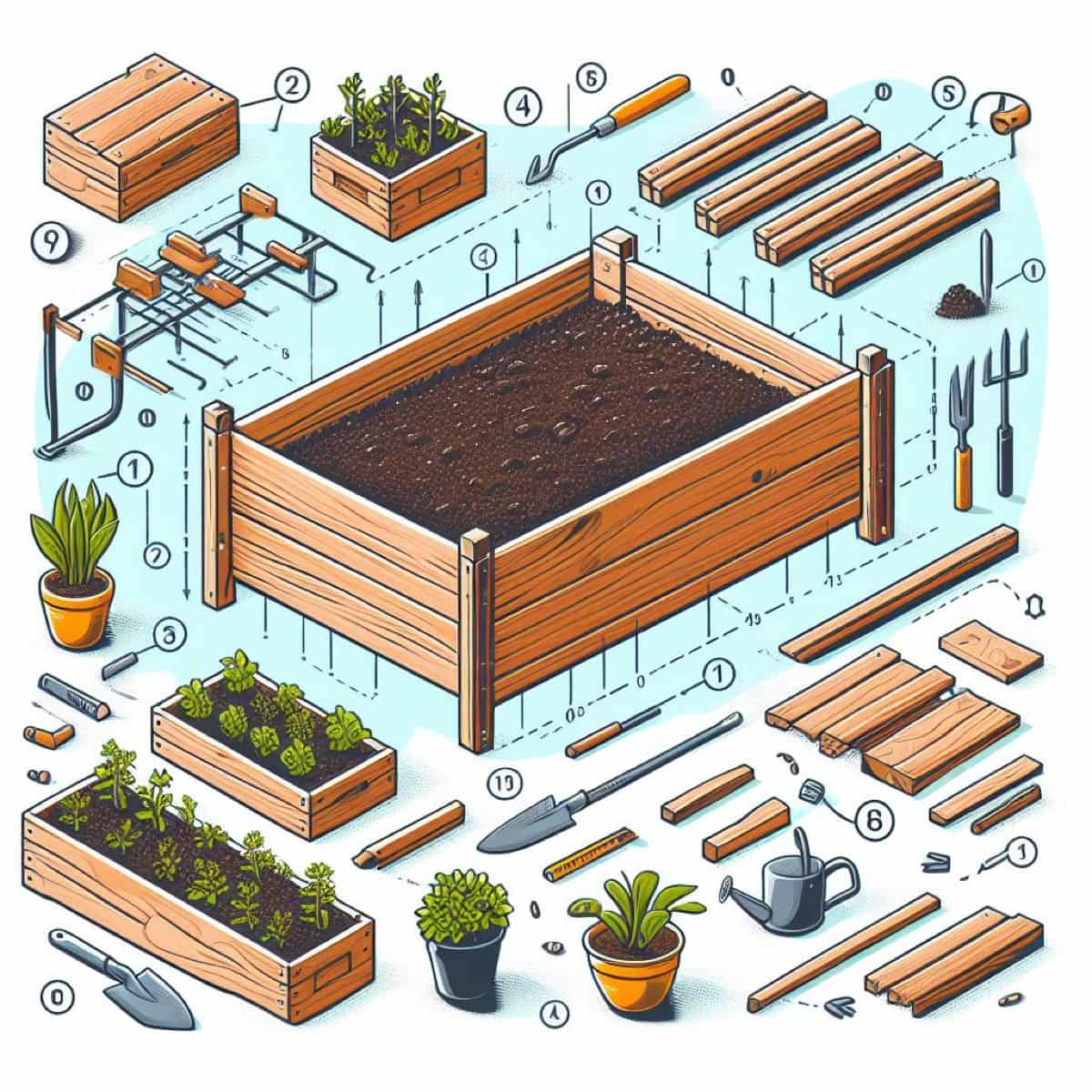
If you have old tires lying around, they can be transformed into unique raised beds by stacking them on top of each other. This method saves money and gives your garden an interesting visual appeal. Reclaimed wood from old fences or furniture can also construct a budget-friendly raised bed.
DIY Pallet Raised Garden Bed: A Cost-Effective Option
If you’re looking for a cost-effective way to build a raised garden bed, consider using pallets. Pallets are versatile and readily available, making them ideal for DIY projects. Plus, repurposing pallets helps reduce waste and gives new life to materials that would otherwise end up in landfills.
To start building your pallet-raised garden bed, first find some sturdy pallets. Look for ones that are in good condition with no rot or damage. You may be able to find free or low-cost pallets from local businesses or online marketplaces. Once you have your pallets, remove any protruding nails or staples. This will help ensure a smooth surface for your plants.
Using Cinder Blocks to Construct a Raised Garden Bed
These versatile building materials are cost-effective and provide excellent stability and longevity for your garden. To start constructing your raised garden bed with cinder blocks, determine your desired size and shape. Lay the cinder blocks in a rectangular or square pattern, ensuring they are level and aligned correctly. Next, fill the center of the cinder block layout with nutrient-rich soil.
In case you missed it: 13 Common Problems with Raised Bed Vegetable Plants: Prevention, Treatment, and Solutions
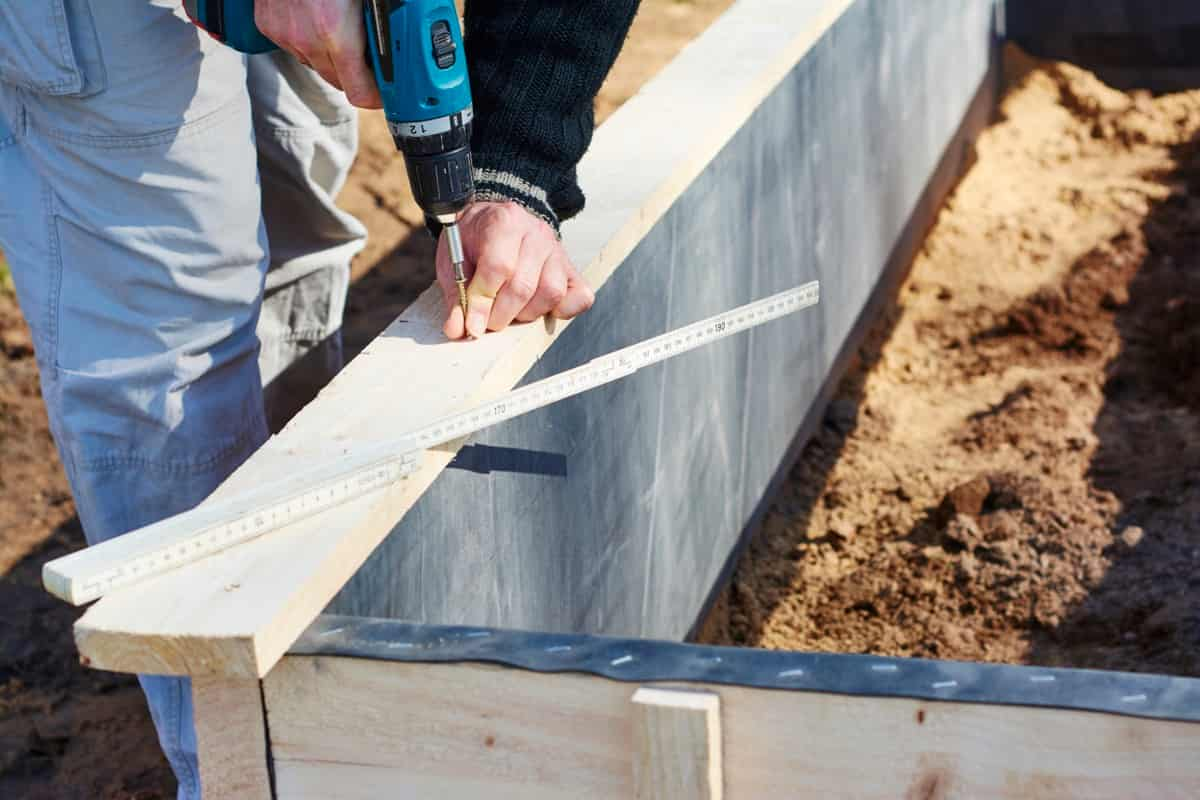
You can mix in compost or fertilizer to ensure optimal plant growth. The hollow centers of the cinder blocks act as individual planting pockets, making it easy to separate different types of plants within one bed. Moreover, if you have limited space or want to add verticality to your garden design, consider stacking additional cinder blocks on top of each other. This allows you to create multiple tiers for planting while still maintaining stability.
Creating a Raised Garden Bed with Old Tires
To get started, gather some old tires in various sizes. Please ensure they are clean and free of sharp objects or debris. Next, choose a location for your garden bed that receives ample sunlight throughout the day. One advantage of using old tires is their ability to retain heat, creating an ideal environment for plants to thrive. Additionally, the flexibility of tires allows you to create unique shapes and designs for your raised garden beds. It is the best inexpensive raised garden bed idea.
Building a Raised Garden Bed with Reclaimed Wood
Reclaimed wood can be a fantastic and sustainable option for constructing your raised garden bed. Not only does it add a rustic charm to your garden, but it also helps reduce waste by repurposing materials. One way to utilize reclaimed wood is by creating a simple frame for your raised bed. You can easily find old pallets or discarded wooden planks that can be cut to the desired size.
Secure them together using screws or nails, and you have yourself an affordable and eco-friendly raised garden bed. Another creative idea to build a raised garden bed is to use old wooden crates as individual planters within your raised bed. These crates provide separate compartments for different plants, making organizing and maintaining your garden easier.
Inexpensive Alternatives to Traditional Raised Garden Bed Materials
One option is using straw bales as the main building material for your raised garden bed. Straw bales are affordable and provide excellent insulation for your plants. Plus, they naturally break down over time, adding nutrients to the soil. Another alternative is repurposing old bricks or concrete blocks. These sturdy materials can be stacked to create a durable raised garden bed structure. Look for used bricks or blocks at local salvage yards or classified ads to keep costs low.
Repurposing Household Items for a Budget-Friendly Raised Garden Bed
One creative way to build a raised garden bed is using old dresser drawers as individual planting beds. Remove the bottom, add drainage holes, and fill them with soil and your favorite plants. This not only adds visual interest to your garden but also provides ample space for different varieties of plants. Another option is transforming old wooden pallets into raised beds. By removing some slats and stacking them together, you can easily create a sturdy structure for your garden.
Just line the inside with landscape fabric or plastic before filling it with soil to prevent weeds from growing through. Old wine barrels can also be repurposed into unique raised gardens. Cut out one side of the barrel and add drainage holes before filling it with soil. This creates an eye-catching focal point in your garden while providing plenty of room for plants to thrive.
Constructing a Raised Garden Bed with Concrete Blocks
Concrete blocks may not be the first material that comes to mind when considering raised garden beds, but they can be an excellent and creative way to build a raised garden bed. Select a location in your outdoor space to create a raised garden bed with concrete blocks. Ensure it receives adequate sunlight and is easily accessible for watering and maintenance. Once you have determined the ideal spot, gather enough concrete blocks to build the desired size of your garden bed.
In case you missed it: How to Improve Drainage in a Raised Garden Bed
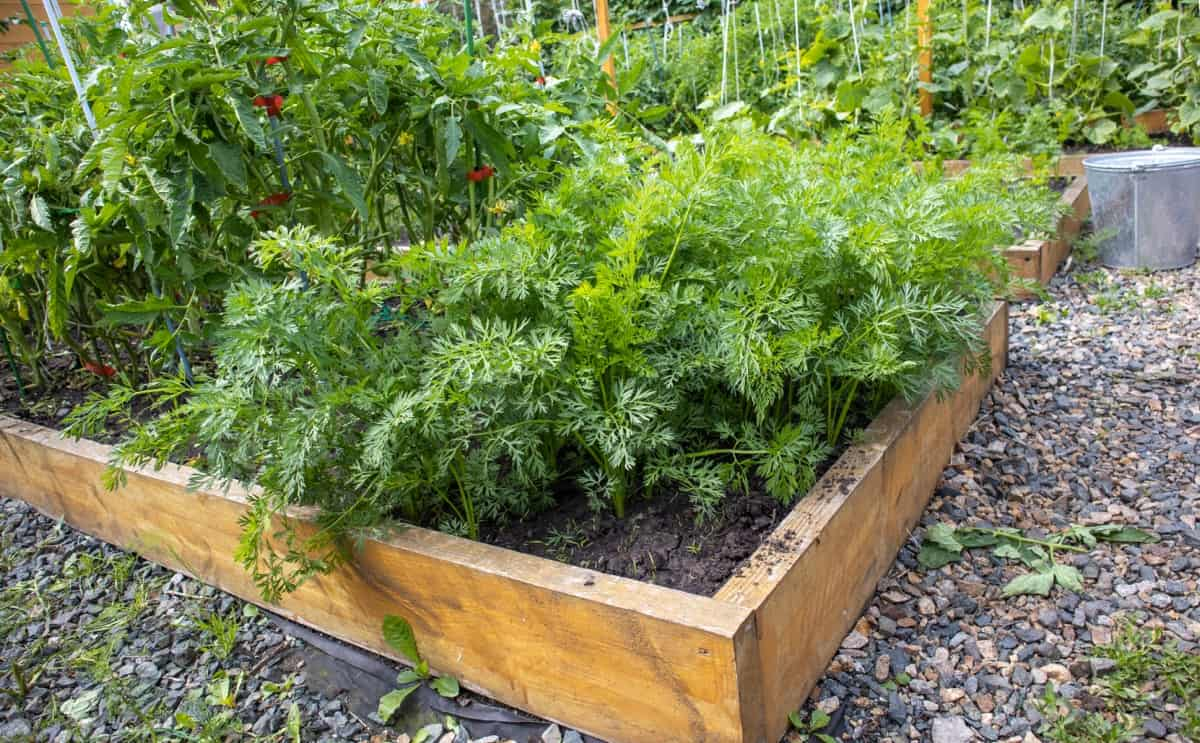
Begin by laying out the first layer of concrete blocks in your desired shape and dimensions. Stack them on each other, ensuring they are level and securely placed. If preferred, you can leave spaces between some blocks to allow drainage or fill them with soil. Continue stacking additional layers of concrete blocks until you reach your desired height. Remember to alternate each layer’s placement pattern for added stability. Once all the layers are in place, fill the raised garden bed with a high-quality soil mixture suitable for growing vegetables or flowers.
Using Straw Bales as an Affordable Raised Garden Bed Option
Using straw bales is a creative way to build a raised garden bed. Straw bales are readily available and relatively inexpensive, making them a budget-friendly choice for those looking to build their own raised beds. Select a sunny location in your yard to create a raised garden bed with straw bales. Lay down several layers of cardboard to suppress vegetation beneath the bed. Place the straw bales side by side in your desired shape, ensuring they are tightly packed together to prevent shifting.
Next, fill the center cavity of each straw bale with nutrient-rich soil or compost. This will serve as the growing medium for your plants. Add organic matter to improve fertility. Once you have filled each straw bale with soil, water thoroughly to activate decomposition within the bales; over time, the straw will break down and provide plant nutrients. It’s important to water regularly throughout the growing season since straw tends to dry out quickly.
Building a Raised Garden Bed with Bricks
Bricks are not just for building walls and walkways; they can also be used to construct a budget-friendly raised garden bed. This method is affordable and provides a durable and long-lasting plant structure. Choose an appropriate location in your yard that receives ample sunlight. Clear the area of any debris or grass before laying down a solid foundation for the bricks. You can use landscape fabric or cardboard as a base layer to prevent weeds from growing through the bed.
In case you missed it: Top 10 Best Vegetables to Grow in Raised Beds: Ultimate Guide for Planting to Harvest
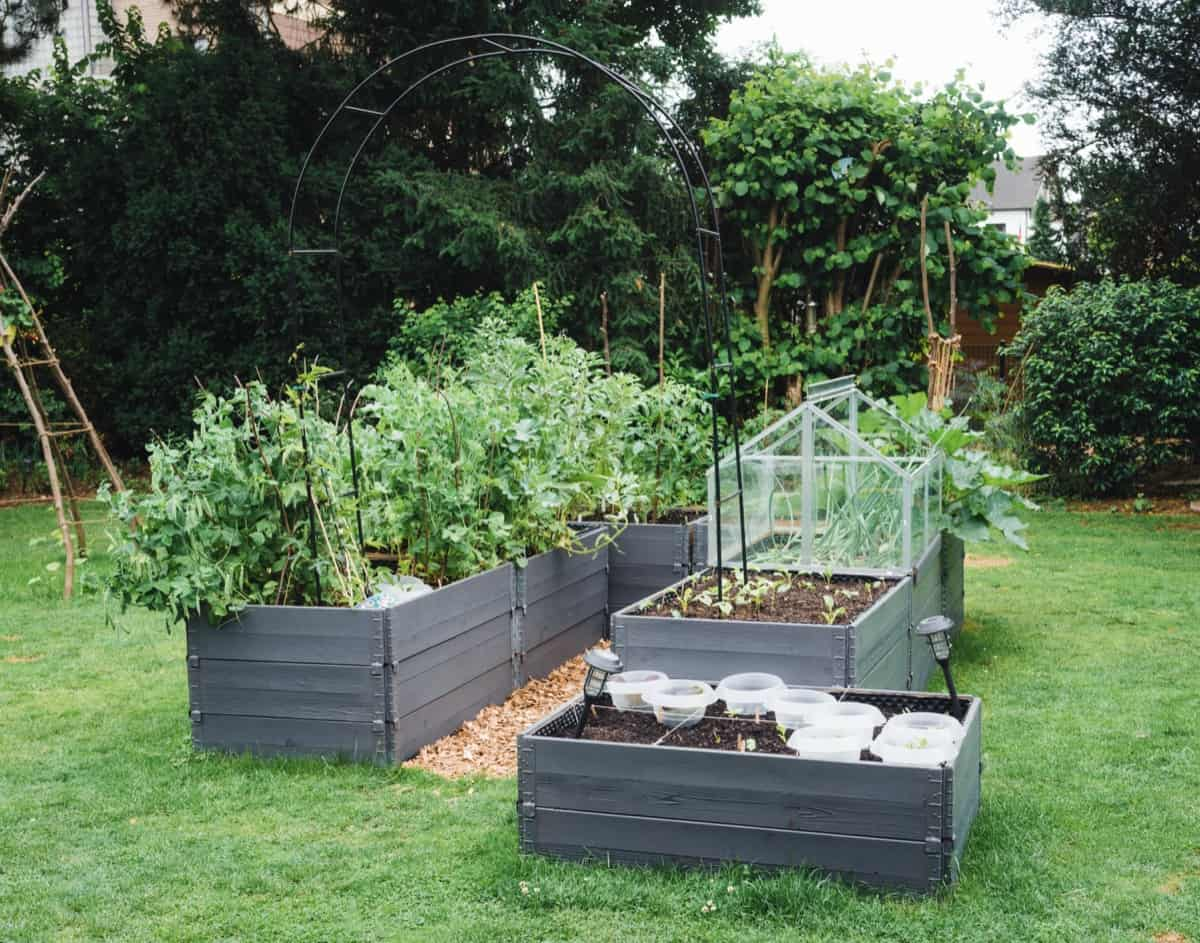
Next, arrange the bricks in your raised garden bed’s desired shape and size. Leave enough space between each brick for proper drainage and airflow. Use mortar or construction adhesive to secure the bricks together, ensuring stability and strength. Once you have completed constructing the walls of the raised garden bed, fill it with nutrient-rich soil suitable for your chosen plants. Add compost or organic matter to enhance fertility and promote healthy plant growth.
Utilizing Gabion Baskets for a Unique and Low-Cost Raised Garden Bed
Gabion baskets are typically used in landscaping projects to create retaining walls or decorative features. However, they can easily be repurposed into raised garden beds. The wire mesh allows for proper drainage while keeping the soil contained, preventing erosion and ensuring healthy plant growth. One of the advantages of using gabion baskets is their affordability.
Compared to traditional building materials, these wire mesh containers offer a budget-friendly option for constructing raised garden beds. Additionally, their modular design allows you to customize the size and shape of your bed according to your preferences. Select the appropriate size and number of baskets to create a gabion basket raised garden bed based on your desired dimensions.
Please place them in your chosen location, ensuring they are level and stable. Fill each basket with rocks or stones until they reach your desired height. Once all the baskets are filled, add a layer of landscape fabric inside each one to prevent soil from escaping through the gaps in the wire mesh. Fill each basket with high-quality gardening soil mixed with compost and begin planting.
Constructing a Raised Garden Bed with Corrugated Metal
To get started, gather the necessary materials: corrugated metal sheets, galvanized screws or nails, wooden posts or planks for the frame, and basic tools like a drill and saw. Measure out the desired dimensions of your raised bed and cut the metal sheets accordingly. Next, assemble the frame by attaching the wooden posts or planks at each corner using screws or nails. Make sure it’s sturdy enough to support the weight of soil when filled.
Once the frame is in place, attach the corrugated metal sheets to each side using screws or nails. Be sure to leave some gaps between them to allow for drainage. Before filling your raised bed with soil, consider adding a layer of landscape fabric at the bottom to prevent weeds from growing through. Then, fill it up with nutrient-rich soil and start planting.
Creating a Budget-Friendly Vertical Garden in a Raised Bed
Vertical gardening is an excellent way to maximize space and add visual interest to your raised bed garden. One cost-effective option for creating a vertical garden in your raised bed is repurposing old pallets. These versatile wooden structures can be easily transformed into planters by attaching small pots or containers to each level. Secure the pallet vertically against one side of your raised bed and fill each container with soil and your desired plants.
In case you missed it: How to Grow Tabasco Peppers from Seeds: At Home, In Pots, Raised Beds, Terraces, and Backyard
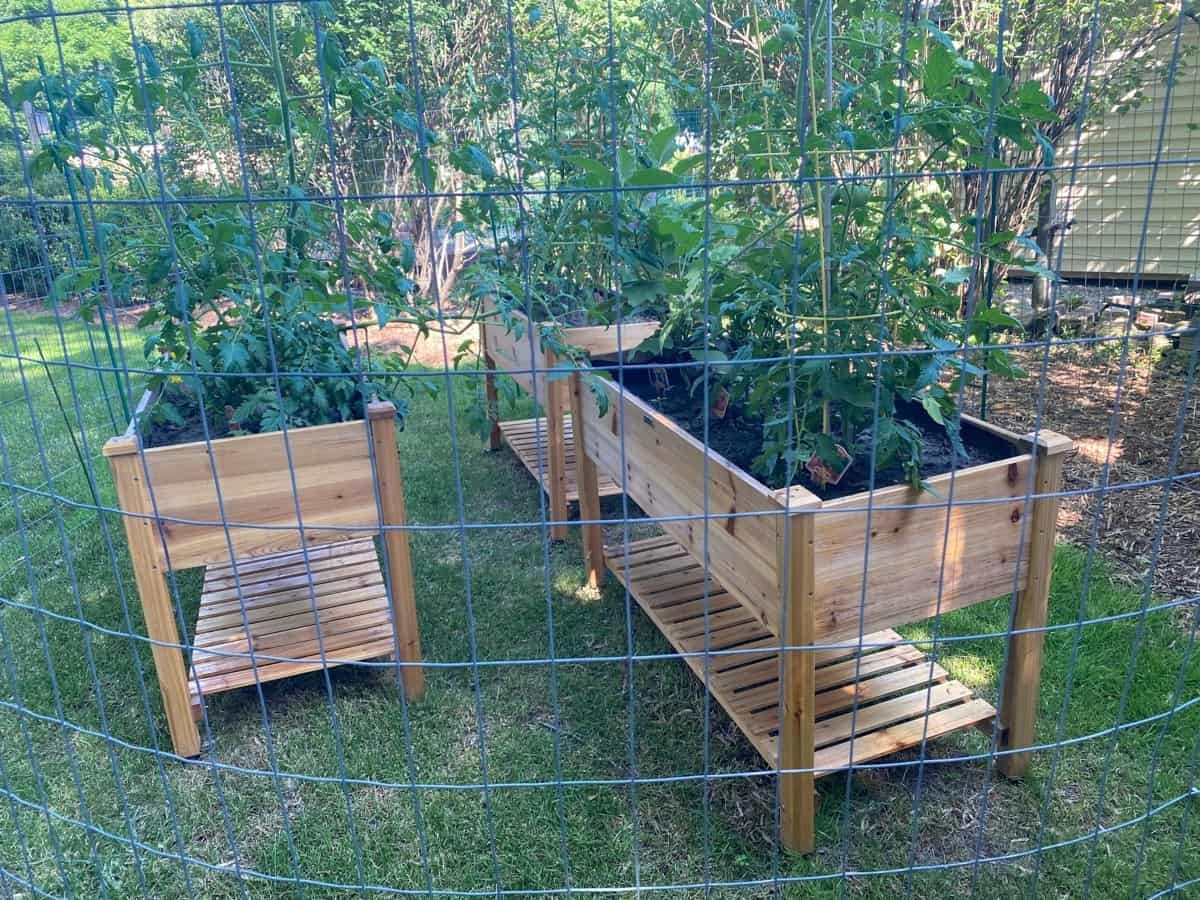
Another creative way to build a raised garden bed is using PVC pipes as vertical planters. Cut the pipes into different lengths, attach them horizontally along the sides of your raised bed, and then insert smaller containers inside each section. This method provides ample growing space while keeping costs low.
Summary of Creative Ways to Build a Raised Garden Bed
| Method | Materials Used | Benefits |
| DIY Pallet Raised Garden Bed | Recycled pallets | Cost-effective and easy to build, making them perfect for beginners |
| Utilizing recycled materials | Old pallets or tires | Cost-effective and environmentally friendly |
| Cinder Block Raised Garden Bed | Cinder blocks | Provide excellent durability and stability |
| Old Tire Raised Garden Bed | Used tires | Creates an interesting visual element in your garden space |
| Reclaimed Wood Raised Garden Bed | Scrap wood | Adds rustic charm to your garden while promoting eco-friendliness by repurposing old materials |
| Repurposing Household Items | Bathtubs, metal tubs, buckets | Budget-friendly raised beds that add creativity to your gardening space |
| Using Straw Bales as Planters | Bales of straw | Create a nutrient-rich environment ideal for plant growth |
| Brick Raised Garden Beds | Bricks | Excellent heat retention properties due to their solid construction |
Conclusion
Raised garden beds are an excellent and effective way to maximize space and improve plant soil conditions. They offer numerous benefits, such as better drainage, easier access to gardening tasks, and protection from pests. Raised beds are typically built with proper drainage systems, preventing waterlogged soil that can lead to root rot and other issues. This ensures that your plants receive just the right amount of moisture they need to grow healthily.
- Flower Garden Designs and Layouts for Beginners
- Planting and Spacing Techniques in Papaya: A Beginner’s Guide
- Growing Gold: Essential Techniques for Planting Pineapples
- How to Make Kalanchoe Plant Bushy: Home Remedies and Solutions
- 11 Reasons Why Your Gardenia is Not Blooming: Home Remedies and Solutions
- Eco Elegance: The Guide to Designing a Drought-Tolerant Landscape
- Gardening on a Slope: Strategies for Hillside Landscaping
- Nourish and Flourish: Top Organic Mulches for Thriving House Plants
- Everything You Want to Know about Indian Mogra Flower: Discover Uses and Growing
- Green Thumb Success: Expert Tips for Cultivating Greenhouse Pumpkins All Year Round
- Maximize Growth & Flavor: The Ultimate Guide to Companion Planting in Herb Gardens
- How to Control Rhododendron Problems Naturally: Home Remedies and Organic Ways to Fix Them
- Natural Magic: The Remarkable Benefits of Cinnamon for Plants
- Best Steps to Revive Dying Tulip with Natural and Organic Treatment
- 10 Reasons Why Your Angel Trumpet is Not Blooming: Remedies and Treatment
- How to Fix Periwinkle Leaf and Flower-Related Problems: Natural Remedies and Solutions
- How to Fix Zinnias Leaf and Flower Problems: Discover Natural and Home Remedies
- Organic Steps to Induce Lemon Tree Flowers: A Comprehensive Guide
- Bloom Booster: Crafting the Perfect Homemade Bougainvillea Fertilizer
- Optimizing Growth: A Guide to Applying NPK Fertilizer for Potted Plants
- 10 Best Homemade Fertilizers for Rubber Plant: DIY Recipes and Application Method
- How to Boost Female Pumpkin Flowers: Effective Steps for More Flowers and High Yields
- Transform Your Indoor Garden: Top Benefits of Pink Salt for Houseplants
- 10 Best Homemade Fertilizers for Peacock Plants (Calathea): Easy DIY Guide
- Unlock Blooms: 9 Reasons Why Your Potted Chrysanthemum is Not Blooming
- 8 Reasons Why Your Potted Hibiscus is Not Blooming: Fix it with Simple Solutions
- Unlock Blooms: 9 Key Reasons Your Potted Frangipani Won’t Flower
- 10 Reasons Why Is My Ice Plant Not Blooming: Remedies and Treatment
- 10 Reasons Why My Potted Hydrangea Not Blooming: Treatment and Remedies
- 10 Reasons Why is My Wisteria Not Blooming: Remedies and Treatment
- 10 Reasons Why is My Goldfish Plant Not Blooming: Remedies and Treatment
- Maximize Your Space: Ultimate Guide to Balcony Gardening with Grow Bags
- 10 Reasons Why Your Iris is Not Blooming: Remedies and Treatment
- 10 Reasons Why Your Anthurium Plant is Not Blooming: Treatment and Remedies
- 10 Reasons Why Your Aquaponic Plants Are Not Flowering: Remedies and Treatment
- 10 Reasons Why Your Agapanthus is Not Flowering: Remedies and Treatment